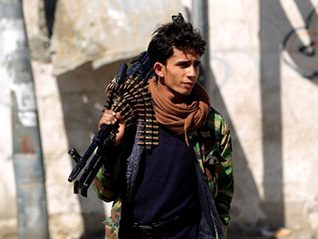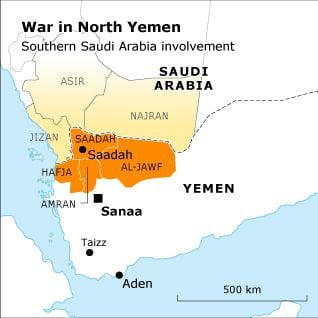
In the vicinity of Saada, the army has been fighting a counter-insurgency war since 2004. The opposing party are the Houthis (al-Huthiyun), a Zaidi opposition group, followers of Hussein Badr Eddin al-Houthi (who was himself killed during the first outburst of violence in 2004). The exact number of casualties down to the present is unknown, although many thousands have died on both sides. The number of displaced persons is over 400,000, many houses having been destroyed in the fighting. Refugee camps have been set up by international refugee organizations in and around Saada, on the Saudi border, and on the west coast.
The conflict centres on government penetration of the Saada region, a traditional stronghold of the Zaidis and the long-time capital of the imamate. The Houthi Faithful Youth movement started to rally wide support in the 1990s, as a reaction to the marginalization of the Zaidi religion. Because of the increasing influence of Saudi Wahhabism – to which many people ‘converted’ as a more lucrative form of Islam – the proportion of Zaidis in the Yemeni population has decreased from about 50 percent to as low as 20 percent in the past three decades. The government repeatedly appointed Wahhabi imams in mosques in Saada, depriving the Zaidis of waqfs (religious foundations) and their communal property. Many Zaidi supporters in Sanaa were taken into custody after fighting erupted in 2004. Hizb al-Haq is the political party representing the movement.

The Yemeni government asserts that the Houthis are an Islamist movement that wants to reinstall the old royal imamate. Before the outbursts of fighting, the Houthis were said to be anti-American fundamentalists and were blamed for attacks on the Jewish community in the north. This seems to have been an attempt to rally global support for the attacks on the Houthis. This image is, however, incorrect. The Zaidi sect may be conservative, but it has always traditionally been moderate and tolerant. The only remaining Yemeni Jews were found in the Zaidi north, where they continued to live alongside the Zaidi tribes after ‘Operation Magic Carpet’ flew tens of thousands of Yemeni Jews to Israel in the 1950s. This lasted until the fourth Houthi war, when, in January 2007, the last remaining Jews were relocated from Saada to Sanaa by the government, reportedly because of threats from the Houthi movement.
According to the government, the Houthis have been backed financially by Iran and Libya. Leading members of the Houthi family have been banned from Yemen but continue to represent the movement in exile. Yahia al-Houthi, a Member of Parliament for Hizb al-Haqq, was stripped of his parliamentary immunity and now lives in Germany. Early in 2007, mediation efforts by the government of Qatar stopped the fighting at times, but in March 2008 larger-scale fighting broke out again, extending southwards to Amran and beyond. In May 2008, Houthis from the urban district of Bani Hushaysh – along the highway from Sanaa to Marib – approached the city of Sanaa and its airport. In what is called the ‘Fifth War’ in the north, journalists reported the engagement in the conflict of American commandos and the Republican brigade, commanded by the President’s son, Ahmed.
The war continued on and off through 2009 and 2010; mutual trust was low, and both sides apparently had difficulty maintaining the Qatari peace agreement. The government reportedly armed opposing Sunni tribes to engage in the fighting. In 2010, Saudi Arabia got involved in the ‘seventh’ war, as Houthi groups penetrated Saudi territory. The Saudi provinces of Asir, Jizan, and Najran are historically and tribally linked to Yemen and have large Zaidi communities. Saudi Arabia reacted by bombing Houthi positions along the border and deeper inside Yemeni territory.
April 2011 saw no ‘eighth’ war, as Yemeni troops were too involved in the uprising in the heartland and in fighting militias in Abyan, and Ali Mohsen al-Ahmar – who, as commander of the northern brigade, was the Houthis’ main adversary –defected to the opposition in March 2011 – at the height of Yemen’s Arab Spring. As a result the Arab Spring saw Houthi hegemony over large parts of the north consolidated and extended well into the provinces of al-Jawf, Amran, and Hajja. The press reported Saada to be the only city in Yemen without shortages of food, water, and fuels. In May, the World Food Program (WFP) announced it had resumed food assistance to the north, calling it a breakthrough, as the WFP would be able to reach areas cut off since the beginning of the conflict, in 2004.
In March 2011 Faris Manna was appointed the new governor of Saada, apparently in collusion with the Houthi leaders, whom he had supplied with arms for some time. In 2008 Manna was blacklisted by the United States as an arms dealer, who allegedly trafficked guns from Eastern Europe to Somalia. Manna was, until 2010, a member of Saleh’s General People’s Congress (GPC) and an ally of the regime in northern wars.

